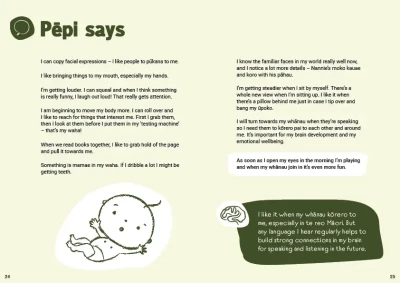
Tāruatia taku reo Copy my sounds
The first sounds pēpi make are a step towards speaking words. Parents can provide an environment rich with language by talking, singing, and copying baby’s sounds.
By Brainwave Trust Aotearoa
Right from birth, babies are learning to talk. The first sounds they make are a step towards speaking words. Parents can provide an environment rich with language by talking, singing and copying baby’s sounds.
Pēpi will begin cooing and gurgling, using ‘oohs’ and ‘aahs’. Then comes babbling. Baby will add on ‘D’s’ and ‘M’s’ and ‘P’s’ to make ‘dada’ and ‘mama’ sounds. Parents can help baby learn a meaning for these sounds by repeating them back in a sentence — “Yes, mama’s getting your bath ready”. Baby will also start to experiment with squealing sounds.
First conversations
Sometimes pēpi will make a sound and then pause, waiting for their parent to make a sound back. Parents can copy baby’s sounds and talk as if they understand what pēpi is saying.
When parents respond to their baby’s sounds, baby learns about turn-taking and the ‘back and forth’ of conversation. Copying sounds encourages babies to make more sounds. They’re learning that they’re worth listening to, and that they have something important to say.
Also, the language areas of baby’s brain are stimulated, and language pathways are built. The more language pēpi hears, the more these areas will be stimulated and grow. Parents need to be close to their baby’s face and look into baby’s eyes when they talk, as very young babies can only see a short distance (about 30 cm).
Noticing body language
Pēpi will use facial expressions and body movements with their vocalisations to communicate how they’re feeling and what they want. So it’s important for parents to read baby’s signals as well as listen to their voice.
Parents can try to name the feeling they think baby’s having, for their baby. This helps baby learn about their feelings as they grow.
Parents often use a higher voice to talk to their pēpi. They speak more slowly and use shorter sentences. This speech is called ‘parentese’. Babies pay more attention to this sort of speech, and their brains process it more easily. Babies love to imitate and will try to copy the sounds that parents make. This helps them learn language.
Babies who are talked with a lot will know more words at a later age. When talked with, pēpi isn’t only learning words. Hearing parents talk and sing helps them learn about building sentences and the rules of grammar.
Baby’s brain processes happy and angry voices in different ways. Their brain is particularly sensitive to voices that sound angry or threatening, and these can stress baby.
Receptive and expressive language
There are two different processes happening when pēpi learns language. ‘Receptive’ language is the language that baby can understand. ‘Expressive’ language is the language that baby can say. Receptive language develops before expressive language.
This means babies are learning about their language well before they can speak it, so it’s never too early for parents to start talking.
When pēpi starts to point, parents can name what baby is pointing to, and can label the things that baby shows an interest in. Parents can talk to baby about what they’re doing. Even everyday chores can sound interesting to pēpi.
Babies who hear language used often, in everyday loving interactions, are more likely to do well at school and become confident, self-motivated learners.
Summary
- Language areas of the brain are stimulated when parents talk to baby and copy their sounds.
- Parentese is easier for baby’s brain to process.
- Babies learn to understand language much earlier than they can speak it.
- Babies who hear lots of language are more likely to become children who do well at school.
Our Whakatipu booklets give parents simple neuroscience information to support them with their parenting. Whakatipu Te Pihinga 1, page 25, pēpi says, ‘I like it when my whānau kōrero to me, especially in te reo Māori. But any language I hear regularly helps to build strong connections in my brain for speaking and listening in the future.’
Try an activity
Face-to-face talking
Baby can learn to take turns making sounds with you. This is the start of having a conversation.













